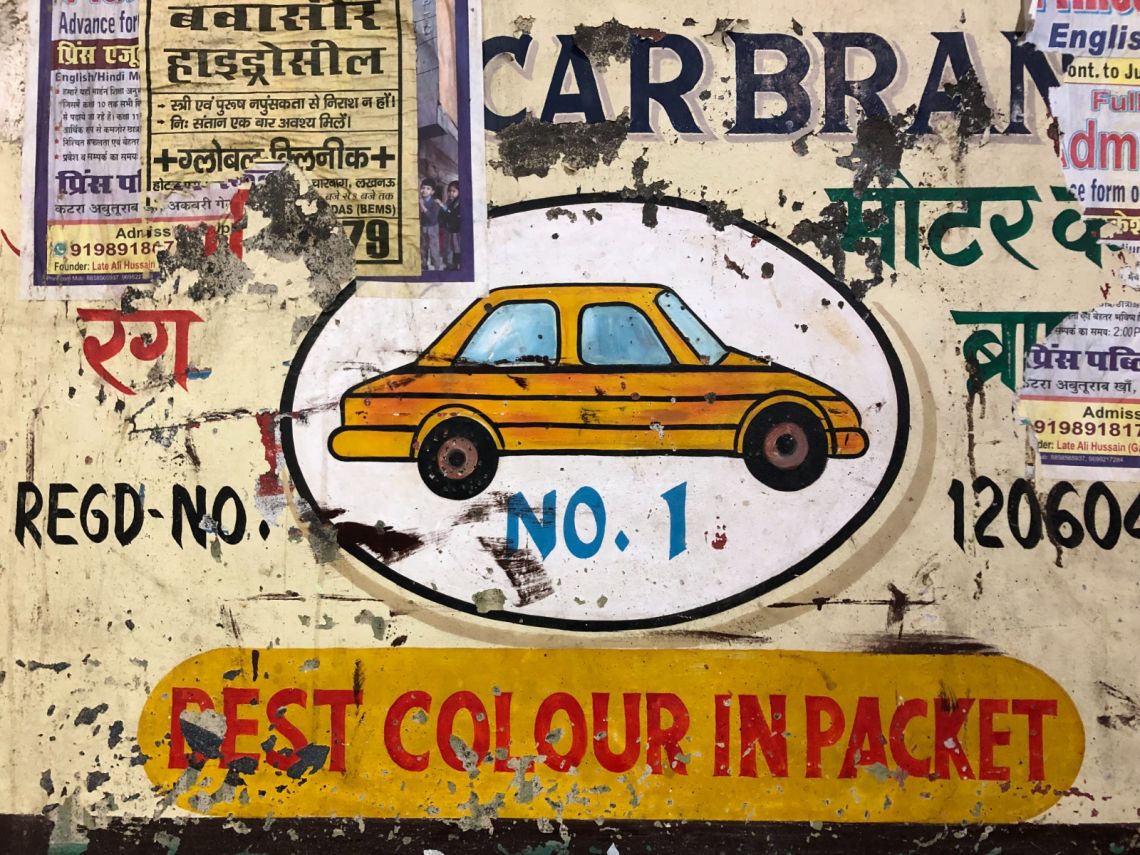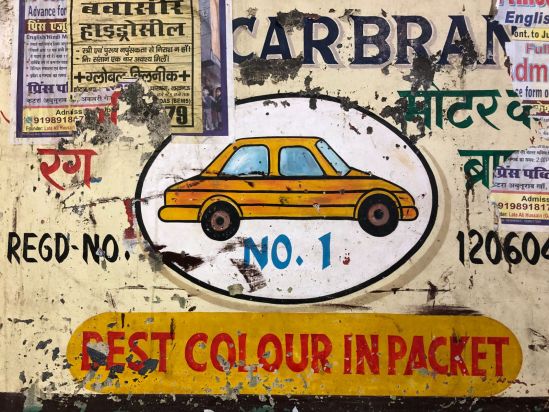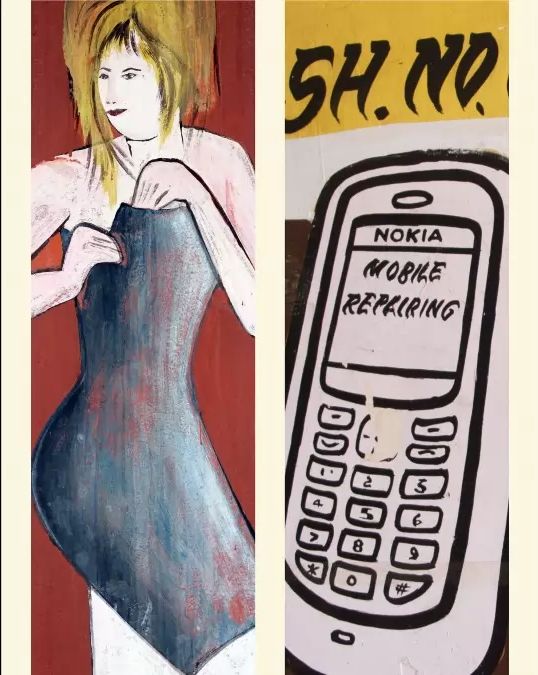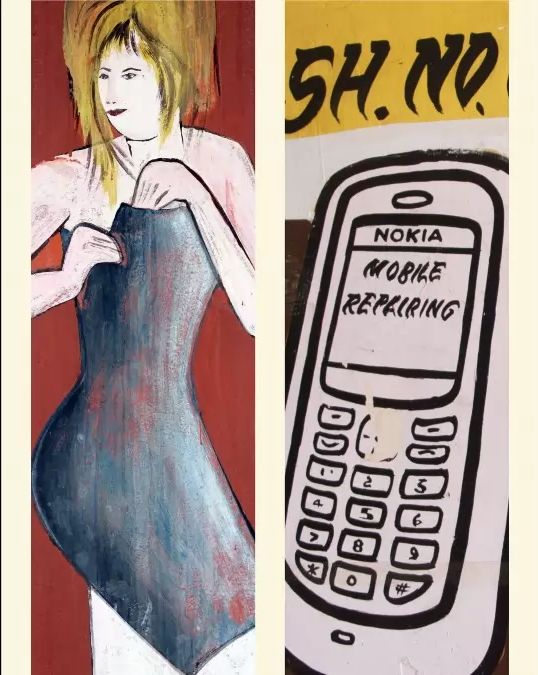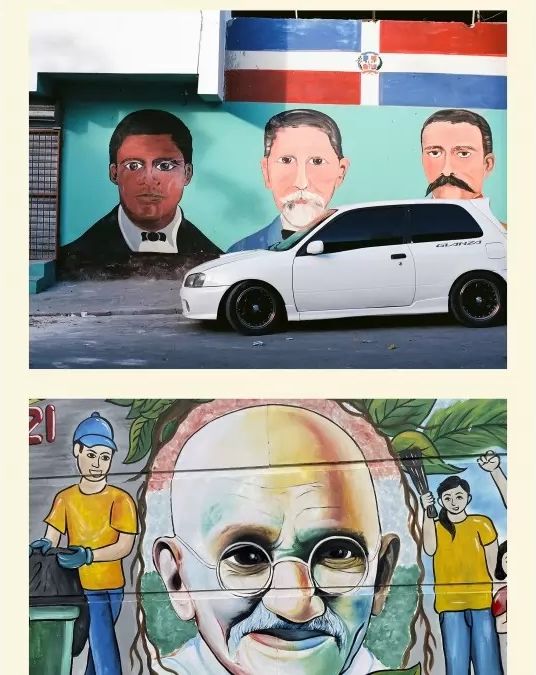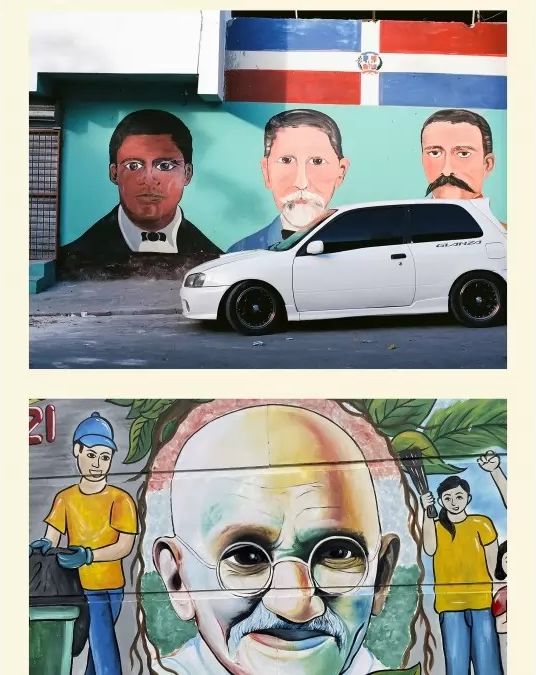Signs from the Street
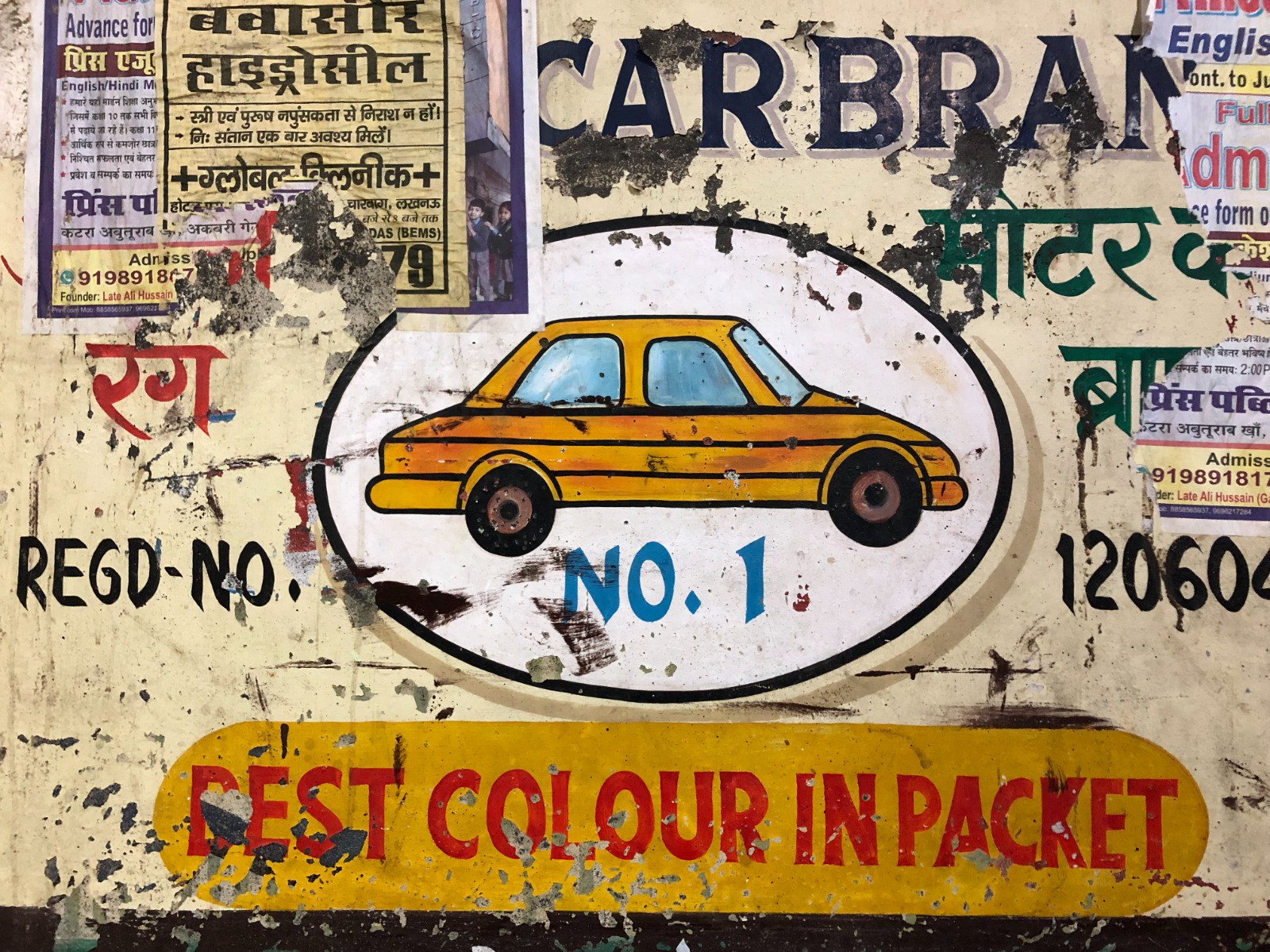
Signs from the Street
Hand-painted signs from India and Dominican Republic
A selection from the archives of Aradhana Seth and Maurice Sánchez
The imagination on display in this exhibition expresses a particular form of creative autonomy found across two disparate contexts, two very different nations. What connects them, however, is the universal language of the vernacular - the rooted, the homespun.
The collection is an agglomeration of everyday life; from local advertisements to restaurant signages, from posters to shopfronts. It encourages an autonomous response from its viewers, a response free from class and caste inhibitions and politically cautious interpretations that appreciate this sense of rootedness.
The images are produced by local artists and artisans, exchanged, and displayed for an immediate, neighborhood audience. They are not circulated as art but as visual codes of familiarity. Codes that invite, seduce and beckon to consume services, goods, and expressions from a known world, in a known world.
The archive helps us recognize and value vernacular modes and moments as they pass us by. It also provides clues and codes to view them in new forms as they continue to be expressed in popular culture. As a visual archive, the collection gathered over the years by Maurice Sánchez in Dominican Republic and Aradhana Seth in India is invaluable precisely because their images express the idea of the vernacular in its richest format.
From Austrian thinker Ivan Illich’s point of view, the vernacular is a toolbox that can help everyone find their space of autonomy and freedom within the most modern of ambitions.
According to lllich – ‘Vernaculum’ is a Latin word, opposed to that which is obtained in formal exchange. For him, the vernacular embodies a sense of empowerment through local control and represents a circle of exchange that is rooted. In his understanding of modernity, it is only by expanding such vernacular spaces, that a genuine sense of freedom can be expressed by individuals and collectives. Such a vernacular roots us in modernity because it provides handles to steer us through bigger and bigger scales of operation by constantly reminding us of the need to be connected to localities and concrete contexts. At the same time, it is never opposed to the global or the regional, but embeds them both in a multitude of networked, interconnected localities.
The images on display in the archive are made for people who understand and belong to their context. In a gallery space, they may sometimes look a bit out of place – but not any more than a private family photo suddenly finding itself in the hands of strangers. That touch of discomfort is inevitable but does not take anything away from the intrinsic value of the archive.
Bringing Seth and Sanchez’s photographs into one space collapses other seemingly impossible worlds – two countries with vastly incomparable scales in every quantifiable possibility, from geography to demographic. Yet they sit beside each other quite seamlessly.
What unites them is a strong defiance of what constitutes a measurable unit to start with; the idea of scale itself. Whether the country is a billion plus or under fifteen million, whether it is small or a subcontinent, it suggests that there must be something special that unites them if they share such similar inner worlds - as they evidently do.
If national sentiments and characteristics cannot be differentiated by physical limits, quantifiable units, and geographical boundaries alone, then what exactly is it that shapes our emotional states and shared imaginations?
Maybe it is the reimagined vernacular space that Illich refers to. A collective memory connected to local, working-class lifestyles. A shared world in both places that is rooted in local exchange and uninhibited expressions.
From Delhi to Santo Domingo, the struggle to maintain autonomy expresses itself in street culture that has its own peculiar idiom. Such streetscapes exist in countries big and small. They are an urban canvas of their own. Local spaces allowing familiar human impulses to express themselves, no matter how different the overarching national context they operate from.
From India to the Dominican Republic, each frame in the exhibition reminds us of this fact. After all, the kind of public space that we occupy with a sense of the greatest familiarity and freedom is that of a local street. And if it is full of traces of agency and everyday expression then the comfort-level is even higher. No matter how big the scale of our belonging - the globe, the continent, or country - it is finally the space of the local through which we eventually relate to a place most tangibly.
Anthropologist Arjun Appadurai is the most eloquent commentator on the local being one of the most important and inevitable frontiers of human existence. And he sees the local as a process in which agency and human action produce their own context all the time.
The ‘local’ is everywhere. Even in the most globalized of spaces. When airport boundaries end, you see their thresholds firmly planted in some local geography reminding you that even this – the most globalized of all structures - must be physically embedded in some place.
The dusty desert sand, the scraggly vegetation peculiar to its region, the distinct trees that appear along roadsides, help re-orient us to where we are. And even from the most exclusive and firewalled hotels, when we take a walk in the neighbourhood, or peek out of the hotel window, we long to see traces of a familiar world in the strangest of countries. If the history of the unknown street in a new country reflects even the slightest familiarity, then no matter if you are from India or the Dominican Republic, the 13500 kilometer-odd distance disappears, and it is as if you have walked home - in either direction.
The streetscape relates to, as Seth and Sanchez put it - the visual language of the everyday locale. Where ‘food, ideal beauty, nation building and religion’ are the themes that dominate.
Seth has been a loyal chronicler of this world for decades. As a visual artist, filmmaker, and designer, she has paid detailed attention to the efforts of fellow artists and artisans from ‘outside’ her world. Together they have recreated a simulacrum of the vernacular on film sets and art galleries alike.
Sanchez, visual artist, and photographer, has done something similar, especially in his collaborative work with the artistic collectives ‘Shampoo’ and ‘Biscuit’ showing work inspired by vernacular practices in galleries around the world and building an Instagram account that documents hand painted signs from his country.
They are both equally at ease in the gallery as they are on the street, equally comfortable with their formal labels as artists as their location in larger collective identities. From conversations with them, we can see how that ease emerges from their at-home demeanor when they are out chronicling and documenting the work of their comrades.
For Sanchez, the city is composed of the relationship between spaces and people. He pays attention to the distinctive ways in which inhabitants’ activities produce improvised spaces and architectural solutions on the go. He is particularly fascinated by the emblematic neighbourhood of Villa Consuelo in Santo Domingo, the capital of the Dominican Republic with its vibrant shops, peddlers selling all kinds of goods, artisanal workshops doing their things with wood, fabric, and metal. The traditional-style dwellings and sidewalks that connect to homes, come alive with food and music and all of this together becomes the context in which the visual culture unfolds. Most of the archive captures the typography and its morphing into illustrations and graphic images that are produced by hand-painters in the pre-digital era. He acknowledges the artistic work of Lolo Jackson who shaped the visual output of many areas of Santo Domingo with his distinctive style.
For Aradhana, many neighbourhoods in Indian towns and cities have a street life that resonates in a startlingly similar way to the one that Sanchez chronicles. A very similar context generates the visual culture on those streets - the production of hand-made visual graphics and shop-front signages. These have a history that goes back several decades, if not centuries, and are an intrinsic part of the identity of local markets, inextricably intertwined into local business practices and artisanship. In the European context, old artisanal and trading guilds took these signages seriously, identifying and decorating themselves and their distinct histories using elaborate metalwork, wood craft and painting jobs to produce a legacy that continues to be part of the visual culture of many neighbourhoods even today.
Seth and Sanchez put a spotlight on a world that shares a similar history and could so easily have been forgotten precisely because of its ‘vernacular’ status, or by being shadowed by the colonial biases that typically ignore the world of ‘native’ attempts at asserting themselves in public spaces. Or deliberately overlooked because they represent a kitschy aesthetic that post-colonial elites are embarrassed by.
By paying attention to the stories behind the visual culture, Seth and Sanchez do more than document the output alone – they land up chronicling entire urban histories. They engage with the producers themselves and the changing world they belong to.
Seth knows many of them personally, like Shakir who settled down in Old Delhi and moved from hand painting to digital graphics with relative ease, and remains confident about his art. Or Raza Abbas who started at a time when hand-painted boards were the norm and remembers fondly the process of apprenticing where he started learning the art of illustration from an established painter in Delhi, Durga Singh. Abbas’ son is an animator who works on computers designing video and mobile games. Then there is Praveen, who Seth met during the shoot of Wes Anderson’s film The Darjeeling Limited when she was looking to collaborate with signage, miniature, truck, and stencil artists from the city of Jodhpur. Or Prashant Janardhan Dalvi, who started apprenticing at a movie poster-painting and signboard making studio in Mumbai and now works on film sets as an art director.
Hidden behind the graphics on display are deep accounts of a transforming urban landscape – the value of which goes beyond that of simply preserving a vanishing world. They capture a moment of hands-on engagement, of creative participation conjoined to the context which produces them.
Just as the physical hand-painted signboards gave way to vinyl and digitally printed posters, the physical world of the streetscape they belong to also changed. From local builders and the involvement by residents in the act of constructing homes and shops or the appropriation of street fronts through every-day acts of living and working, the neigbourhoods themselves began to be produced in newer ways. They were/are being transformed into real estate assets, mass-manufactured, industrially constructed and accounted inch by inch into contemporary cities.
Yet – the visual world of Sanchez and Seth continues to flourish in many global contexts in some form or the other. Homegrown neighbourhoods continue to proliferate in cities no matter how modern – because there are limits to the resources that city governments have, or there are simply too many people for them to handle. A glitzy, towering city such as Shenzen in China still has half its population living in urban villages where the vernacular continues to assert itself. Where the same grammar of graphics that we see in Seth’s Delhi and Sanchez’s Santo Domingo remains alive and thriving in computer generated street art.
And even in older settled iconic cities, from Berlin to Paris, the human hand re-appears in the form of graffiti art, like phantom, shadowy presences, doing their work at night, claiming the street physically by imprinting their walls with their physical touch. It is only with that tangible connection that they truly feel they belong to the city or that the city belongs to them. And if we look carefully, we see similarities in the way the graffiti artists produce their images and the homage they pay to the simplest of drawings that their predecessors did in streetscapes from another era using tools and techniques that are now lost.
In Seth and Sanchez’s lively, colourful, and honest collection, each image - whether a reinvented religious or national icon, a brightly painted bowl of fruit, a sexy model, or a poetic landscape - represents a similar touch of the human hand. A hand that seeks to capture a piece of their world onto the street, using the economic apparatus of the local market to express their collective ownership of that space.
The images are striking because they are direct, sensual and clear in their intention. Their simplicity is part of the package – as it is through this feature that they communicate to their neighbors with maximum transmission of meanings. They faithfully represent how people as neighbors and people with a shared sense of belonging think, live and see the world. As subjects of desire for human bodies, or food or any other object of circulation and exchange.
The visual archives of Seth and Sánchez offer a protected space for practitioners who can easily be forgotten, mainly because they operate from what Illich refers to as shadow spaces. The vernacular in the modern world tends to become invisible, because it cannot be so easily enumerated, audited, accounted, and taxed. Yet for Illich, those are the very qualities that make the vernacular a resource for another future, one in which its value, rooted in ordinary human action and agency, can be rightfully recognized for what it is, an immeasurable resource to help us escape the perennial threat of being controlled, managed and even infantilized.
In this sense, the idea of the vernacular allows us to restore domesticated, everyday-exchanges to their rightful place but in unexpected ways, with surprising shapes and contours. Where the familiar domains of the home (in its infinite variety), the family (in new modes), the community (organized afresh) the streetscape (reimagined) and genders (always in the plural) provide choices for the future that have not yet been explored.
In this universe of creativity, the street has a special place. More than any other, the street allows for a greater degree of freedom to play around with possibilities. Almost all of the art that Seth and Sánchez's archive is literally located on the street. That lively space between the home and the world, where futures can be expressed in all kinds of ways, with a sense of freedom and abandonment that is genuinely out of control.
The street is a place of exchange, of inter-action that still facilitates, at least in the contexts in which the artists operate, a degree of autonomy from regimes of control. Streets are usually dense with action and can become a labyrinthine maze to get lost in. They tend to occupy an impossible existence, on the cross-roads of familiarity and anonymity, freedom and security.
In an urban world where space is audited to its last square millimeter, where the visual culture that wraps around its physical structures are rapidly transformed into ephemeral digital flashes, their archive does not simply capture a vanishing world, but puts the spotlight on a space of accidental freedom that was rarely acknowledged to start with. The artists, artisans and designers in the archive - often oblivious of these labels - represent a sense of autonomy from definitions and control that have become part and parcel of modern living.
In a paradoxical twist, despite all the possibilities of freedom and the granting of independence to individual identities, modernity demands something valuable in return. To be counted as an individual, to be freed from traditional communities, also means one had to give up control of one’s agency and the immediate, local environment. One has to become subservient to large and abstract mechanisms of state or private institutional control and their enumerating, taxing, auditing and extractive systems.
Such transactions and exchanges are not always smooth, structured or voluntary for a lot of people. Those who resist giving up control of their land, resources or labour are ostracized, punished or persecuted through modern, institutional mechanisms. Those who do not fit into larger imaginaries (which have come to swiftly substitute traditional communities) continue to be treated like outcasts. Gender is reduced to a duality and fitted into an abstract, neutered, individuated, consumer-citizen ideal. Culture and community are mechanically expanded into larger nationalist frames.
At the same time resistance does happen. Wherever autonomy can be expressed it is and often by those who have lost everything or have little to lose. The raw material used for such resistance inevitably includes bodies, skills, labour, art, community support systems, traditional cultural practices and local identities of those who resist.
The status-quo represents their efforts as backward, traditional, anti-modern when often what they are doing is fighting a take-over of their own agency and productive capabilities. However, because their resources, and social imagination includes community framed cultural practices, it is easy to forget that they are also fighting for new ways of being. Not the new that is often thrust down in the name of modernity, typically accompanied by heavy-handed institutions and burdensome bureaucracies, by narrow definitions and straight-jacketed roles, but the new that does not squash their agency. The new that is willing to accept their desire to continue controlling their lives.
Historically tribal movements, peasant rebellions, anti-colonial struggles, feminist movements, trans-rights, housing rights resistances and slum and squatter movements have often about control of local selves, skills and resources.
If today we have to struggle to list successful movements on this track of aspirations at a global level, it only goes to show how successfully modern mechanisms have co-opted our understanding of freedom and agency and how easily modern citizens have given up their autonomy and freedom to run their lives.
It is this sense of autonomy that Illich hoped will blossom once more in our future. He hoped that we would soon realize the futility of institutions and structures that try to limit the infinite patterns in which human lives can be arranged and imagined. This sense of autonomy can help find that sweet spot between labels that transcend narrowly defined oppositions such as anarchy versus state-control or community versus institutional rigidity. A spot that Illich believed was nestled within the space of the vernacular, when seen as a resource for creative agency and a direct engagement with our lives.
In this collection, each image has a hidden story and behind each story is an emotion that links the image and the image maker to the place they all belong to. This embodied connection is what Illich believed was the stuff of a truly free spirit that exists in vernacular practices. With such connections comes a greater degree of control over lives, which he also referred to as the ‘art of dwelling.’
It is this art of dwelling that needs to be remembered. With a reminder that some of it still exists and that it does have a future. By locating it between the worlds of technology, skills, localities, embodiment, and the environment, shaped by human engagement, and a fierce desire to take charge of our lives, we can still have hope. And in the meanwhile, also some fun appreciating the accompanying imaginary that comes along - irreverential, simple, lively, and vernacular.
Works Cited:
Appadurai Arjun: Modernity at large, University of Minnesota Press 1996.
Illich Ivan: Shadow Work, M Boyars 1981.
Online dialogue between Aradhana Seth and Maurice Sánchez in December 2021, https://www.dominicanembassy.in/blogcult2021/vernacular-graphic-design.
